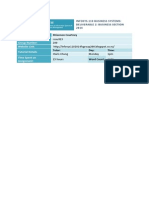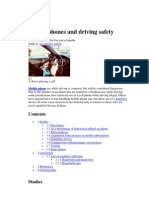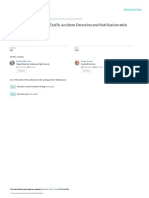E10 Assignment 1
E10 Assignment 1
Uploaded by
Ivan ChenCopyright:
Available Formats
E10 Assignment 1
E10 Assignment 1
Uploaded by
Ivan ChenCopyright
Available Formats
Share this document
Did you find this document useful?
Is this content inappropriate?
Copyright:
Available Formats
E10 Assignment 1
E10 Assignment 1
Uploaded by
Ivan ChenCopyright:
Available Formats
An Engineer's Perspective Assignment 01
Ivan L Chen Word Count: 914 September 2, 2011
a.
Cell phone use in a vehicle has been constantly reviewed by academic and federal authorities
due to the concern that distracted driving resulting from the increased use of electronic devices has led and will continue to lead to car accidents and deaths. Multiple statistics have shown that the use of electronic devices has led to riskier driving. Using a cell phone in a vehicle for more than 50 minutes per month is associated with a 559% increased risk to be involved in a traffic accident (Sugano, 13). Handsfree devices have been touted as a solution to distracted driving, but some studies have shown that while driving safety is greatly improved, the problems of communication while driving still exist. Compared to the 900% increased risk of being involved in a car accident while using a phone, the 200% increased risk while using hands-free devices is still substantial (Sugano, 13). From the New Jersey
Department of Transportation records dating from 2006 to 2008, drivers using hands-free phones were involved in 4,530 crashes. In the same time frame, 5,541 crashes due to illegal use of hand-held cell phones occurred (Harper). Because the user base of those who use hands-free phones is much greater than those who illegally use hand-held cell phones while driving, the statistics convey that using handsfree devices alleviates much driver distraction. It may seem easy to just eliminate any distraction altogether by making all cell phone use illegal but studies estimate that the loss of the ability to use a cell phone in a car through such regulations would cost close to $23 billion in productivity (Hahn, 11). The distractions while using a hands-free device can be closely associated with speaking with a passenger in the car because both divert the driver's attention without the driver having to take a hand off the wheel. The majority of distractioncaused accidents that occur are related to eating or smoking; cell phone use only constitutes 11% of all distracted accidents (Provisional). For these reasons, it seems to be more appropriate to allow the use of hands-free devices but to eliminate all usage of hand-held devices, thus abating much of the distraction that cell phones bring while keeping productivity largely intact. It would be the balance between taking too much action and no action at all.
b.
In theory, having restrictions on all future hand-held cell phones to prevent people from using
them while driving is a great idea but it seems rather hard to implement. What seems like a possible solution is the Key2SafeDriving product which is installed through software into the cell phone and then connected to a device attached to the dashboard of a car. When the car is in ignition, the device reroutes all calls directly to voicemail and blocks all other communications as well. However, this device is designed for people under the care of someone else as the set up is handled by an administrator and removal of the rerouting device sends messages to the administrator. It is clearly not meant to be used on a wide scale and it would be an unnecessary hassle for states to have to monitor these devices. A new product by ZoomSafer takes the problem of wide-scale applicability and solves many of the issues. It focuses on employees in businesses who drive company cars or trucks. The system is installed through software on cell phones rather than through hardware by phone manufacturers and it can detect whether a person is driving in a car or not through a network connection. It prohibits the receiving of emails or texts while the driver is operating the vehicle while enabling hands-free calling. This would be very useful for those operating in businesses but it does not cover the actions of the employees outside of business hours nor does it cover phones that do not transmit data. The
ZoomSafer is only able to work because the employees do not use public transit or ride as a passenger in other vehicles during working hours, avoiding many of the problems that would befall from those situations. Programs such as ZoomSafer appear to be able to be implemented on a large scale but forcing manufacturers to create safety switches on new phones does bring up many auxiliary problems. It could detect if the occupant was moving at the speed of a car if it had a network connection but how does the phone differentiate between a driver in a car and a passenger in a car or if the occupant is sitting on a bus rather than driving a car? Access to the internet from cell phones is not widespread enough to
implement the tracking technology even if the technology were able to differentiate between bus and car travel. If such policies were implemented, it would only affect a fraction of the cell phone-using population as well as stagnate the cell phone industry as it is likely that people would be hesitant to adopt the new changes and purchase new phones that are required to have safety switches. There is also the problem that there will continue to be non-data cell phones on the market for years to come and to restrict only the cell phone users that have access to the internet would be looked down upon by the public and businesses. Also, there is always the option for cell phone users to turn off their network connectivity temporarily which would render the restrictions useless. To force all these factors to work would severely limit personal freedom unless solutions can be found for the several obstacles posed. In the end, it seems like the best solution would be to leave safety switches out of cell phones until new revolutionary ideas can allow for a seamless transition that allows for both freedom and safety.
Bibliography
"FleetSafer Mobile Proactively Prevents Employee Cell Phone Use While Driving | ZoomSafer." ZoomSafer Prevents Distracted Driving. Web. 01 Sept. 2011. <http://zoomsafer.com/products/fleetsafer/mobile/>. Hahn, R. W., & Tetlock, P. C. (1999). The economics of regulating cellular phones in vehicles. Washington, DC: American Enterprise Institute-Brookings Joint Center for Regulatory Studies. Harper, Derek. "Statistics Show Hands-free Cell Phone Use While Driving Is Just as Dangerous." Press of Atlantic City. 23 May 2010. Web. 01 Sept. 2011. Provisional 2001 Statewide Collection Totals and Selected Inattentions. Rep. Sacramento: CHP Office of Public Affairs, 2002. "Safe Driving Systems." Safe Driving Systems, LLC | Stay Alive. Hang Up and Drive!Web. 01 Sept. 2011. <http://safedrivingsystems.com/products/>. Sugano, Dean. Cell Phone Use and Motor Vehicle Collisions: A Review of the Studies. Rep. Vol. 4. Honolulu: Legislative Reference Bureau, 2005. Print.
You might also like
- Powerscreen 2Document2 pagesPowerscreen 2damodarvajja0% (1)
- Should Cellphones Be Banned While Driving - ModifiedDocument6 pagesShould Cellphones Be Banned While Driving - Modifiedchandanpalai91100% (1)
- Mission Ol - BoilerDocument4 pagesMission Ol - BoilerPsk alxNo ratings yet
- Mobile Phones and Driving: English ProjectDocument22 pagesMobile Phones and Driving: English ProjectPrashant Paul KerkettaNo ratings yet
- Report On The Dangers of Cellphone Use While DrivingDocument6 pagesReport On The Dangers of Cellphone Use While DrivingMitchell JacksonNo ratings yet
- Investigating Driver Reaction Time and Speed During Mobile Phone Conversations With A Lead Vehicle in Front A Driving Simulator Comprehensive StudyDocument21 pagesInvestigating Driver Reaction Time and Speed During Mobile Phone Conversations With A Lead Vehicle in Front A Driving Simulator Comprehensive StudySubhash PasupuletiNo ratings yet
- Phones and Accidents - EditedDocument6 pagesPhones and Accidents - Editedmusa imanNo ratings yet
- Design and Precautionary Measure For Mobile Phone Accidents While DrivingDocument7 pagesDesign and Precautionary Measure For Mobile Phone Accidents While DrivingInternational Organization of Scientific Research (IOSR)No ratings yet
- Forenzika Mobilnih TelefonaDocument8 pagesForenzika Mobilnih TelefonaZijadNo ratings yet
- Advances in TechnologyDocument6 pagesAdvances in TechnologyAnonymous vTDrPQpp8eNo ratings yet
- Project Proposal TemplateDocument3 pagesProject Proposal TemplateGlenda Lizel BiceraNo ratings yet
- Transportation Research Part F: Oscar Oviedo-Trespalacios, Mark King, Atiyeh Vaezipour, Verity TrueloveDocument12 pagesTransportation Research Part F: Oscar Oviedo-Trespalacios, Mark King, Atiyeh Vaezipour, Verity TruelovepadmavathiNo ratings yet
- Maddie Fisher PhoneDocument5 pagesMaddie Fisher Phoneapi-366595717No ratings yet
- A Driving Simulator Study To Understand TheDocument14 pagesA Driving Simulator Study To Understand TheSubhash PasupuletiNo ratings yet
- Nalysis of The Iterature: T M P DDocument48 pagesNalysis of The Iterature: T M P DbertouwNo ratings yet
- Cell Phones While Driving Thesis StatementDocument7 pagesCell Phones While Driving Thesis Statementfjbr4n2n100% (2)
- Distracted DrivingDocument14 pagesDistracted DrivingAkhilesh Kumar SinghNo ratings yet
- Cell Phone While Driving Thesis StatementDocument7 pagesCell Phone While Driving Thesis Statementmelanierussellvirginiabeach100% (2)
- Ersosynthesis2018 CellphoneDocument35 pagesErsosynthesis2018 CellphoneninaanjaNo ratings yet
- Thesis Statement For Banning Cell Phones While DrivingDocument6 pagesThesis Statement For Banning Cell Phones While Drivingcarlamolinafortwayne100% (2)
- ResearchDocument6 pagesResearchS Naruto Shippuden AMVNo ratings yet
- Technological Advancement of Automotive IndustryDocument6 pagesTechnological Advancement of Automotive IndustryaspectNo ratings yet
- Autonomus Vehicle Original 2Document9 pagesAutonomus Vehicle Original 2Vaibhav ThakareNo ratings yet
- Thesis Statement For Cell Phones While DrivingDocument7 pagesThesis Statement For Cell Phones While Drivingbarbtillichfargo100% (2)
- 2015-11-30 Discouraging Distracted Driving Mike Hodgson FinalDocument7 pages2015-11-30 Discouraging Distracted Driving Mike Hodgson Finalapi-314717796No ratings yet
- Infosys110 Deliverable 2Document9 pagesInfosys110 Deliverable 2rhiannoncourtneyNo ratings yet
- Mobile Phones and Driving SafetyDocument23 pagesMobile Phones and Driving Safetyanon_263923202No ratings yet
- Distracted Driving Lesson Packet - 2021Document10 pagesDistracted Driving Lesson Packet - 2021Kaitlyn FlippinNo ratings yet
- ToolboxTalks Aug3 PDFDocument2 pagesToolboxTalks Aug3 PDFvikubhardwaj9224No ratings yet
- WreckWatch Automatic Traffic Accident Detection AnDocument29 pagesWreckWatch Automatic Traffic Accident Detection AnManikantareddy KotaNo ratings yet
- Cellular Phone Use While Driving: Risks and BenefitsDocument100 pagesCellular Phone Use While Driving: Risks and Benefitsabdikarim_omarNo ratings yet
- Exemplification Essay: Advantages & Disadvantages of CellphonesDocument3 pagesExemplification Essay: Advantages & Disadvantages of Cellphonesمتعلم لغة أنجليزيةNo ratings yet
- OUMH2203Document11 pagesOUMH2203Siti Lorena EdmundNo ratings yet
- WreckWatch Automatic Traffic Accident Detection AnDocument29 pagesWreckWatch Automatic Traffic Accident Detection AnEmariel LumagbasNo ratings yet
- Blog 5Document3 pagesBlog 597 Tanuja NeharkarNo ratings yet
- Reserch Paper (023 & 112)Document6 pagesReserch Paper (023 & 112)Vineet JainNo ratings yet
- Funambol SyncML BookDocument29 pagesFunambol SyncML BooksimishuNo ratings yet
- Thesis Statement On Banning Cell Phones While DrivingDocument5 pagesThesis Statement On Banning Cell Phones While Drivingjamiemillerpeoria100% (2)
- Tanyaradzwa Mare Research Project Chapter1-5 2023Document14 pagesTanyaradzwa Mare Research Project Chapter1-5 2023tapiwamuchenje123No ratings yet
- Literature Review On Driver Distraction 2013 Summer Student ReportDocument49 pagesLiterature Review On Driver Distraction 2013 Summer Student ReportThanatos LaevateinnNo ratings yet
- Don't Poke Me I'm DrivingDocument5 pagesDon't Poke Me I'm DrivingSatria Bayu KrisnaNo ratings yet
- Investigating The Effect of Area Type and Traffic Conditions On Distracted Driving PerformanceDocument11 pagesInvestigating The Effect of Area Type and Traffic Conditions On Distracted Driving PerformanceWilson Arias-RojasNo ratings yet
- Lit ReviewDocument16 pagesLit ReviewViệt Anh NguyễnNo ratings yet
- Research Paper-Adam DonahueDocument12 pagesResearch Paper-Adam Donahueapi-468051482No ratings yet
- Role of Mobile in The Modern WorldDocument5 pagesRole of Mobile in The Modern Worldjunaid0% (1)
- Role of Mobile in The Modern WorldDocument4 pagesRole of Mobile in The Modern WorldjunaidNo ratings yet
- Cell Phone Ad DisDocument8 pagesCell Phone Ad DisisnaizinNo ratings yet
- Eetimes 1 PDFDocument13 pagesEetimes 1 PDFJuan Francisco Pulido CarrilloNo ratings yet
- Mobile Internet For The Next Two Billion PDFDocument8 pagesMobile Internet For The Next Two Billion PDFNaseef Us SakibNo ratings yet
- Dc-656837-V1-Torts of The Future Autonomous EmailableDocument20 pagesDc-656837-V1-Torts of The Future Autonomous EmailablejulianNo ratings yet
- (544436410) Wreckwatch - TradusDocument15 pages(544436410) Wreckwatch - TradusDaniela Alexandra LungeanuNo ratings yet
- Drink and Drive DocsDocument38 pagesDrink and Drive Docsproxyone taskNo ratings yet
- While Driving: Mobile Phones and Driving Safety Texting While DrivingDocument4 pagesWhile Driving: Mobile Phones and Driving Safety Texting While Drivingkate trishaNo ratings yet
- Policy Implications of Autonomous VehiclesDocument16 pagesPolicy Implications of Autonomous VehiclesCato InstituteNo ratings yet
- Allen Emma 2.iiiDocument5 pagesAllen Emma 2.iiiLawrd RrafieNo ratings yet
- IT MajorDocument7 pagesIT Majorminmochi15704No ratings yet
- Group 2 (Textalyzer) CscsDocument19 pagesGroup 2 (Textalyzer) CscscyrstalNo ratings yet
- Name Netid Group Number: Website Link: Tutorial Details Time Spent On AssignmentDocument8 pagesName Netid Group Number: Website Link: Tutorial Details Time Spent On AssignmentHeather JohnstonNo ratings yet
- Ai Autonomous Vehicles Paper Exp 1cDocument17 pagesAi Autonomous Vehicles Paper Exp 1cakshayaharitha8No ratings yet
- Vehicle Infrastructure Integration: Unlocking Insights and Advancements through Computer VisionFrom EverandVehicle Infrastructure Integration: Unlocking Insights and Advancements through Computer VisionNo ratings yet
- Mobile Security Products for Android: (No) Security for the Android PlatformFrom EverandMobile Security Products for Android: (No) Security for the Android PlatformNo ratings yet
- Traffic Enforcement Camera: Advancements in Computer Vision for Traffic Enforcement CamerasFrom EverandTraffic Enforcement Camera: Advancements in Computer Vision for Traffic Enforcement CamerasNo ratings yet
- DC To AC Inverter Part 3Document11 pagesDC To AC Inverter Part 3faraheenNo ratings yet
- Udemy C - Cpi - 13Document26 pagesUdemy C - Cpi - 13mohananudeepNo ratings yet
- S924A - Instruction ManualDocument28 pagesS924A - Instruction ManualIsaias MirellesNo ratings yet
- S4H - 471 Integration Scenario ListDocument38 pagesS4H - 471 Integration Scenario ListLokesh ModemzNo ratings yet
- F-Super Duty/Excursion 2004 - Early Build 6.0L Power Stroke Diesel Engine Performance Diagnostic GuideDocument1 pageF-Super Duty/Excursion 2004 - Early Build 6.0L Power Stroke Diesel Engine Performance Diagnostic GuidevixentdNo ratings yet
- Jaypee University of Engineering & Technology, Guna Deparment of Computer Science & EngineeringDocument4 pagesJaypee University of Engineering & Technology, Guna Deparment of Computer Science & Engineeringgauravsagar311No ratings yet
- While Cryptography Looked Different in Early CivilizationsDocument11 pagesWhile Cryptography Looked Different in Early Civilizationsemepa23No ratings yet
- Rail Operation DesignDocument24 pagesRail Operation DesignImran SabbirNo ratings yet
- Woodward Synchronizing Module Spec GCP30Document4 pagesWoodward Synchronizing Module Spec GCP30nooruddinkhan1100% (1)
- Use of Multimedia As A New Educational TechnologyDocument4 pagesUse of Multimedia As A New Educational TechnologyArsip Mahasiswa100% (2)
- El Perro Y El Cocodrilo ResumenDocument7 pagesEl Perro Y El Cocodrilo Resumene3tqes2b100% (1)
- Features of VB. NET Programming LanguageDocument2 pagesFeatures of VB. NET Programming LanguageAbdul-halim HafidhNo ratings yet
- Encouraging Citizen Use of ICT in Service Delivery: A DiscussionDocument3 pagesEncouraging Citizen Use of ICT in Service Delivery: A Discussionmiddlemanj128No ratings yet
- IT Essentials (Version 5.0) - ITE Chapter 12: Assessment ResultsDocument5 pagesIT Essentials (Version 5.0) - ITE Chapter 12: Assessment ResultsshanoNo ratings yet
- TeSys LT3 - LT3SA00EDDocument2 pagesTeSys LT3 - LT3SA00EDVincent Ferrer NironNo ratings yet
- DIY IR Sensor Module Circuit DiagramDocument13 pagesDIY IR Sensor Module Circuit DiagramHimanshu guptaNo ratings yet
- 1.assignment On Terotechnology and Reliability Engineering For BSC Electrical Class Final Year StudentsDocument7 pages1.assignment On Terotechnology and Reliability Engineering For BSC Electrical Class Final Year StudentsCharles OndiekiNo ratings yet
- CPM Wood Pelleting ProcessDocument2 pagesCPM Wood Pelleting ProcessJosé Alberto Andrade Díaz100% (1)
- Reviewer ItecDocument8 pagesReviewer IteclyzzasanmiguelNo ratings yet
- Pad ReonDocument11 pagesPad ReonMd Mahademasud ReonNo ratings yet
- S. Asha: National Institute of Technology RourkelaDocument30 pagesS. Asha: National Institute of Technology RourkelaAayush ThapaNo ratings yet
- lp13 Tyoes of StorageDocument16 pageslp13 Tyoes of StorageBochai BagolorNo ratings yet
- Kpi GMML V1Document77 pagesKpi GMML V1Erick AlvaradoNo ratings yet
- "Marketing Strategies of Airtel" - 2Document84 pages"Marketing Strategies of Airtel" - 2Master PrintersNo ratings yet
- Simple Animated Morph PPT Template by GEMO EDITSDocument41 pagesSimple Animated Morph PPT Template by GEMO EDITSMonch LacedaNo ratings yet
- JSA For Elevator PITDocument9 pagesJSA For Elevator PITmanish sharmaNo ratings yet
- MAN ChassisDocument24 pagesMAN ChassisPrihastya WishnutamaNo ratings yet
- NICE3000new Integrated Elevator Controller User Manual-1 PDFDocument209 pagesNICE3000new Integrated Elevator Controller User Manual-1 PDFImtiaz Hussain100% (1)

























































































